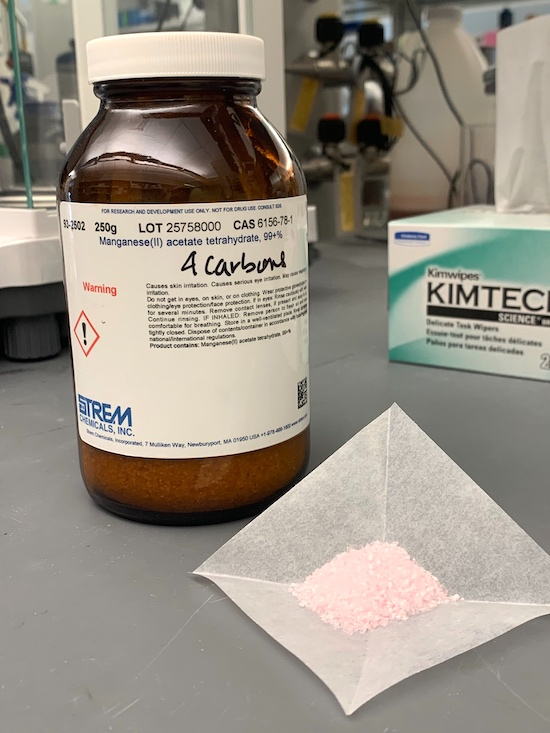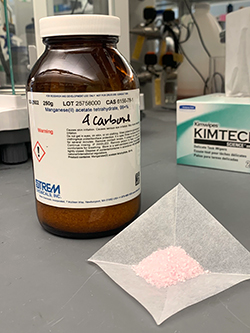Manganese Makes Its Mark in Drug Synthesis
Rice lab finds common metal more efficient at catalyzing pharma building blocks
Just because you’ve solved a standing chemistry challenge doesn’t mean you can’t make it better. Rice University scientists had that in mind when they set out to improve their technique to make a common building block for drugs.
 Manganese is superior to silver and cerium as a way to make building blocks for drug design and manufacture, according to Rice University researchers. Photo by Yen-Chu Lu
Manganese is superior to silver and cerium as a way to make building blocks for drug design and manufacture, according to Rice University researchers. Photo by Yen-Chu Lu
Rice chemist Julian West and graduate student Yen-Chu Lu found that an Earth-abundant salt of manganese further simplifies the process of synthesizing fluoroketones, precursor molecules for drug design and manufacture.
The complex method required catalysts of expensive silver until the West lab figured out how to replace it with a cerium-based compound. That in turn led the researchers to eye manganese as a next-level catalyst.
The lab reported its results in the American Chemical Society journal ACS Catalysis.
Attaching negatively charged fluorine atoms to ketones, biological compounds with a variety of structures, helps direct the functional groups toward desired reactions when used in anticancer and other compounds, West said. He noted in the previous study that replacing hydrogen atoms with fluorines “is like armor plating at that position” and helps drugs last longer in the body.
Manganese has several advantages over cerium, West said, and not just for its easy availability and low cost.
“The amount of product we got with cerium was good, but for it to work, we had to use as much cerium as starting material,” said West, an assistant professor of chemistry. “With manganese, we required less than a 10th as much catalyst -- and more importantly, it just works better. We would rather use a trace amount of catalyst to save on material costs and to simplify purification.”
 Julian West
Julian West  Yen-Chu Lu
Yen-Chu Lu
And while cerium was able to promote reactions with relative efficiency, it was essentially one-and-done.
Cerium can be recycled for reuse as a catalyst but it requires a difficult reoxidization. That turned out to be much easier with manganese salts. “Yen-Chu found the reagent we use, Selectfluor, reoxidizes the manganese enough to react again and again,” he said.
Manganese is also cheap enough that recycling the material may not be cost effective for manufacturers, West said.
The only downside, he said, is that manganese-enabled reactions can take several hours to produce a batch of molecules as opposed to the half-hour or so needed by cerium. But even that limitation should prove no obstacle because of the relative cost, he said.
“In our view, that’s a fair tradeoff, because you’re reducing the amount of reagents you need to add and getting more of the compound that you want,” West said.
He said head-to-head comparisons with silver catalysts proved manganese delivered more product molecules with half the amount of catalyst. “So I think we’re getting to state-of-the-art catalysis with this reaction.”
The Cancer Prevention and Research Institute of Texas (RR190025) and the Robert A. Welch Foundation (C-2085) supported the research.
More resources:
 To download a high resolution version, visit https://bit.ly/3BePMCp
To download a high resolution version, visit https://bit.ly/3BePMCp
Publication: Yen-Chu Lu, et al., C–C Bond Fluorination via Manganese Catalysis, ACS Catalysis (2021). DOI: 10.1021/acscatal.1c03052
Original Story Source: Rice University

 Alerts Sign-up
Alerts Sign-up